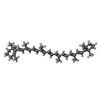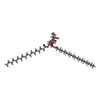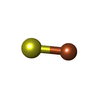[English] 日本語
 Yorodumi
Yorodumi- EMDB-0281: Structure of the photosynthetic complex I from Thermosynechococcu... -
+ Open data
Open data
- Basic information
Basic information
| Entry | Database: EMDB / ID: EMD-0281 | ||||||||||||||||||
|---|---|---|---|---|---|---|---|---|---|---|---|---|---|---|---|---|---|---|---|
| Title | Structure of the photosynthetic complex I from Thermosynechococcus elongatus | ||||||||||||||||||
 Map data Map data | Structure of the photosynthetic complex I from Cyanobacteria | ||||||||||||||||||
 Sample Sample |
| ||||||||||||||||||
 Keywords Keywords | Respiratory Complex / Ferredoxin / Cyclic electron flow / Complex I / Membrane protein complex / PROTON TRANSPORT | ||||||||||||||||||
| Function / homology |  Function and homology information Function and homology informationTranslocases; Catalysing the translocation of protons; Linked to oxidoreductase reactions / NADH dehydrogenase complex / transmembrane transporter complex / photosynthetic electron transport chain / oxidoreductase activity, acting on NAD(P)H, quinone or similar compound as acceptor / NADH dehydrogenase activity / plasma membrane-derived thylakoid membrane / photosynthesis, light reaction / ubiquinone binding / electron transport coupled proton transport ...Translocases; Catalysing the translocation of protons; Linked to oxidoreductase reactions / NADH dehydrogenase complex / transmembrane transporter complex / photosynthetic electron transport chain / oxidoreductase activity, acting on NAD(P)H, quinone or similar compound as acceptor / NADH dehydrogenase activity / plasma membrane-derived thylakoid membrane / photosynthesis, light reaction / ubiquinone binding / electron transport coupled proton transport / respiratory chain complex I / NADH dehydrogenase (ubiquinone) activity / quinone binding / ATP synthesis coupled electron transport / endomembrane system / aerobic respiration / NAD binding / 4 iron, 4 sulfur cluster binding / iron ion binding / membrane / plasma membrane Similarity search - Function | ||||||||||||||||||
| Biological species |   Thermosynechococcus elongatus (strain BP-1) (bacteria) / Thermosynechococcus elongatus (strain BP-1) (bacteria) /   Thermosynechococcus elongatus BP-1 (bacteria) Thermosynechococcus elongatus BP-1 (bacteria) | ||||||||||||||||||
| Method | single particle reconstruction / cryo EM / Resolution: 3.34 Å | ||||||||||||||||||
 Authors Authors | Schuller JM / Schuller SK | ||||||||||||||||||
| Funding support |  Germany, Germany,  Japan, 5 items Japan, 5 items
| ||||||||||||||||||
 Citation Citation |  Journal: Science / Year: 2019 Journal: Science / Year: 2019Title: Structural adaptations of photosynthetic complex I enable ferredoxin-dependent electron transfer. Authors: Jan M Schuller / James A Birrell / Hideaki Tanaka / Tsuyoshi Konuma / Hannes Wulfhorst / Nicholas Cox / Sandra K Schuller / Jacqueline Thiemann / Wolfgang Lubitz / Pierre Sétif / Takahisa ...Authors: Jan M Schuller / James A Birrell / Hideaki Tanaka / Tsuyoshi Konuma / Hannes Wulfhorst / Nicholas Cox / Sandra K Schuller / Jacqueline Thiemann / Wolfgang Lubitz / Pierre Sétif / Takahisa Ikegami / Benjamin D Engel / Genji Kurisu / Marc M Nowaczyk /     Abstract: Photosynthetic complex I enables cyclic electron flow around photosystem I, a regulatory mechanism for photosynthetic energy conversion. We report a 3.3-angstrom-resolution cryo-electron microscopy ...Photosynthetic complex I enables cyclic electron flow around photosystem I, a regulatory mechanism for photosynthetic energy conversion. We report a 3.3-angstrom-resolution cryo-electron microscopy structure of photosynthetic complex I from the cyanobacterium The model reveals structural adaptations that facilitate binding and electron transfer from the photosynthetic electron carrier ferredoxin. By mimicking cyclic electron flow with isolated components in vitro, we demonstrate that ferredoxin directly mediates electron transfer between photosystem I and complex I, instead of using intermediates such as NADPH (the reduced form of nicotinamide adenine dinucleotide phosphate). A large rate constant for association of ferredoxin to complex I indicates efficient recognition, with the protein subunit NdhS being the key component in this process. | ||||||||||||||||||
| History |
|
- Structure visualization
Structure visualization
| Movie |
 Movie viewer Movie viewer |
|---|---|
| Structure viewer | EM map:  SurfView SurfView Molmil Molmil Jmol/JSmol Jmol/JSmol |
| Supplemental images |
- Downloads & links
Downloads & links
-EMDB archive
| Map data |  emd_0281.map.gz emd_0281.map.gz | 3.7 MB |  EMDB map data format EMDB map data format | |
|---|---|---|---|---|
| Header (meta data) |  emd-0281-v30.xml emd-0281-v30.xml emd-0281.xml emd-0281.xml | 30.3 KB 30.3 KB | Display Display |  EMDB header EMDB header |
| Images |  emd_0281.png emd_0281.png | 114 KB | ||
| Filedesc metadata |  emd-0281.cif.gz emd-0281.cif.gz | 8.9 KB | ||
| Archive directory |  http://ftp.pdbj.org/pub/emdb/structures/EMD-0281 http://ftp.pdbj.org/pub/emdb/structures/EMD-0281 ftp://ftp.pdbj.org/pub/emdb/structures/EMD-0281 ftp://ftp.pdbj.org/pub/emdb/structures/EMD-0281 | HTTPS FTP |
-Validation report
| Summary document |  emd_0281_validation.pdf.gz emd_0281_validation.pdf.gz | 210.8 KB | Display |  EMDB validaton report EMDB validaton report |
|---|---|---|---|---|
| Full document |  emd_0281_full_validation.pdf.gz emd_0281_full_validation.pdf.gz | 209.9 KB | Display | |
| Data in XML |  emd_0281_validation.xml.gz emd_0281_validation.xml.gz | 5.9 KB | Display | |
| Arichive directory |  https://ftp.pdbj.org/pub/emdb/validation_reports/EMD-0281 https://ftp.pdbj.org/pub/emdb/validation_reports/EMD-0281 ftp://ftp.pdbj.org/pub/emdb/validation_reports/EMD-0281 ftp://ftp.pdbj.org/pub/emdb/validation_reports/EMD-0281 | HTTPS FTP |
-Related structure data
| Related structure data |  6humMC 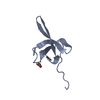 6a7kC M: atomic model generated by this map C: citing same article ( |
|---|---|
| Similar structure data |
- Links
Links
| EMDB pages |  EMDB (EBI/PDBe) / EMDB (EBI/PDBe) /  EMDataResource EMDataResource |
|---|---|
| Related items in Molecule of the Month |
- Map
Map
| File |  Download / File: emd_0281.map.gz / Format: CCP4 / Size: 103 MB / Type: IMAGE STORED AS FLOATING POINT NUMBER (4 BYTES) Download / File: emd_0281.map.gz / Format: CCP4 / Size: 103 MB / Type: IMAGE STORED AS FLOATING POINT NUMBER (4 BYTES) | ||||||||||||||||||||||||||||||||||||||||||||||||||||||||||||
|---|---|---|---|---|---|---|---|---|---|---|---|---|---|---|---|---|---|---|---|---|---|---|---|---|---|---|---|---|---|---|---|---|---|---|---|---|---|---|---|---|---|---|---|---|---|---|---|---|---|---|---|---|---|---|---|---|---|---|---|---|---|
| Annotation | Structure of the photosynthetic complex I from Cyanobacteria | ||||||||||||||||||||||||||||||||||||||||||||||||||||||||||||
| Projections & slices | Image control
Images are generated by Spider. | ||||||||||||||||||||||||||||||||||||||||||||||||||||||||||||
| Voxel size | X=Y=Z: 1.35 Å | ||||||||||||||||||||||||||||||||||||||||||||||||||||||||||||
| Density |
| ||||||||||||||||||||||||||||||||||||||||||||||||||||||||||||
| Symmetry | Space group: 1 | ||||||||||||||||||||||||||||||||||||||||||||||||||||||||||||
| Details | EMDB XML:
CCP4 map header:
| ||||||||||||||||||||||||||||||||||||||||||||||||||||||||||||
-Supplemental data
- Sample components
Sample components
+Entire : photosynthetic complex I
+Supramolecule #1: photosynthetic complex I
+Macromolecule #1: NAD(P)H-quinone oxidoreductase subunit 1
+Macromolecule #2: NAD(P)H-quinone oxidoreductase subunit 3
+Macromolecule #3: NAD(P)H-quinone oxidoreductase chain 4 1
+Macromolecule #4: NAD(P)H-quinone oxidoreductase subunit 4L
+Macromolecule #5: NAD(P)H-quinone oxidoreductase subunit 2
+Macromolecule #6: NADH dehydrogenase subunit 6
+Macromolecule #7: NAD(P)H-quinone oxidoreductase subunit J
+Macromolecule #8: Proton-translocating NADH-quinone dehydrogenase subunit P NdhP
+Macromolecule #9: NAD(P)H-quinone oxidoreductase subunit H
+Macromolecule #10: NAD(P)H-quinone oxidoreductase subunit I
+Macromolecule #11: NAD(P)H-quinone oxidoreductase subunit K
+Macromolecule #12: NAD(P)H-quinone oxidoreductase subunit L
+Macromolecule #13: NADH dehydrogenase subunit 5
+Macromolecule #14: NAD(P)H-quinone oxidoreductase subunit N
+Macromolecule #15: NAD(P)H-quinone oxidoreductase subunit M
+Macromolecule #16: Tlr0636 protein
+Macromolecule #17: NAD(P)H-quinone oxidoreductase subunit O
+Macromolecule #18: Proton-translocating NADH-quinone dehydrogenase subunit Q NdhQ
+Macromolecule #19: BETA-CAROTENE
+Macromolecule #20: 1,2-DISTEAROYL-MONOGALACTOSYL-DIGLYCERIDE
+Macromolecule #21: IRON/SULFUR CLUSTER
-Experimental details
-Structure determination
| Method | cryo EM |
|---|---|
 Processing Processing | single particle reconstruction |
| Aggregation state | particle |
- Sample preparation
Sample preparation
| Buffer | pH: 8 |
|---|---|
| Vitrification | Cryogen name: ETHANE-PROPANE |
- Electron microscopy
Electron microscopy
| Microscope | FEI TITAN KRIOS |
|---|---|
| Image recording | Film or detector model: GATAN K2 SUMMIT (4k x 4k) / Average electron dose: 49.93 e/Å2 |
| Electron beam | Acceleration voltage: 300 kV / Electron source:  FIELD EMISSION GUN FIELD EMISSION GUN |
| Electron optics | Illumination mode: FLOOD BEAM / Imaging mode: BRIGHT FIELD |
| Experimental equipment |  Model: Titan Krios / Image courtesy: FEI Company |
- Image processing
Image processing
| Startup model | Type of model: INSILICO MODEL |
|---|---|
| Final reconstruction | Resolution.type: BY AUTHOR / Resolution: 3.34 Å / Resolution method: FSC 0.143 CUT-OFF / Number images used: 133485 |
| Initial angle assignment | Type: MAXIMUM LIKELIHOOD |
| Final angle assignment | Type: PROJECTION MATCHING |
 Movie
Movie Controller
Controller












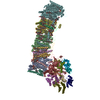
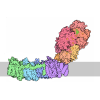


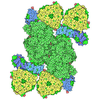




 Z (Sec.)
Z (Sec.) Y (Row.)
Y (Row.) X (Col.)
X (Col.)





















